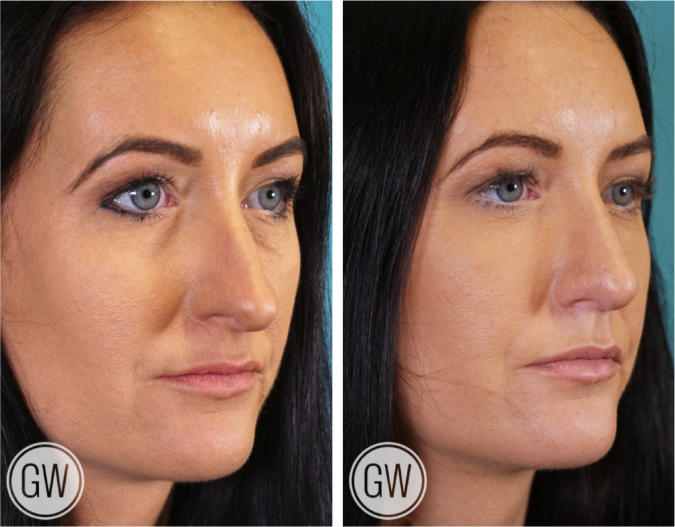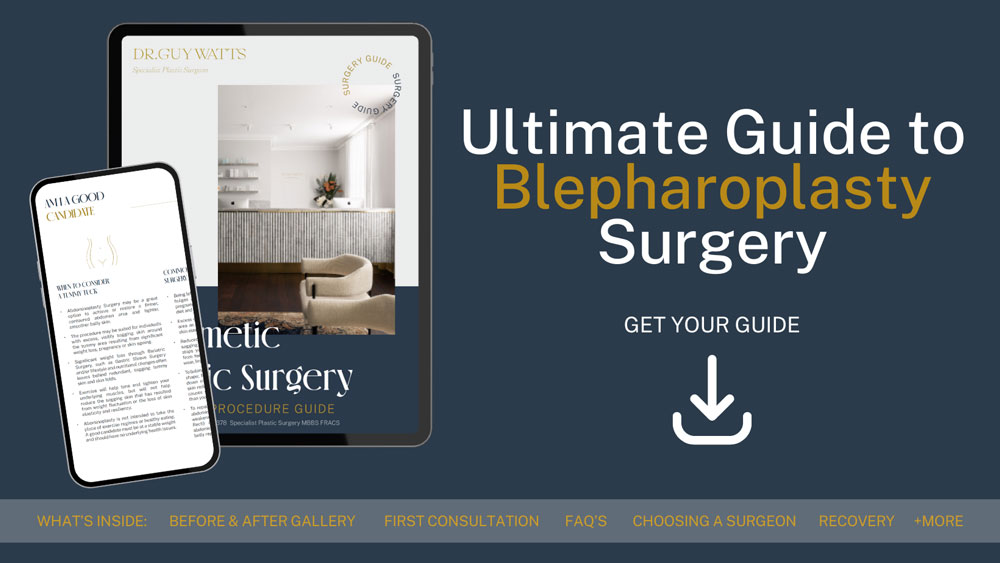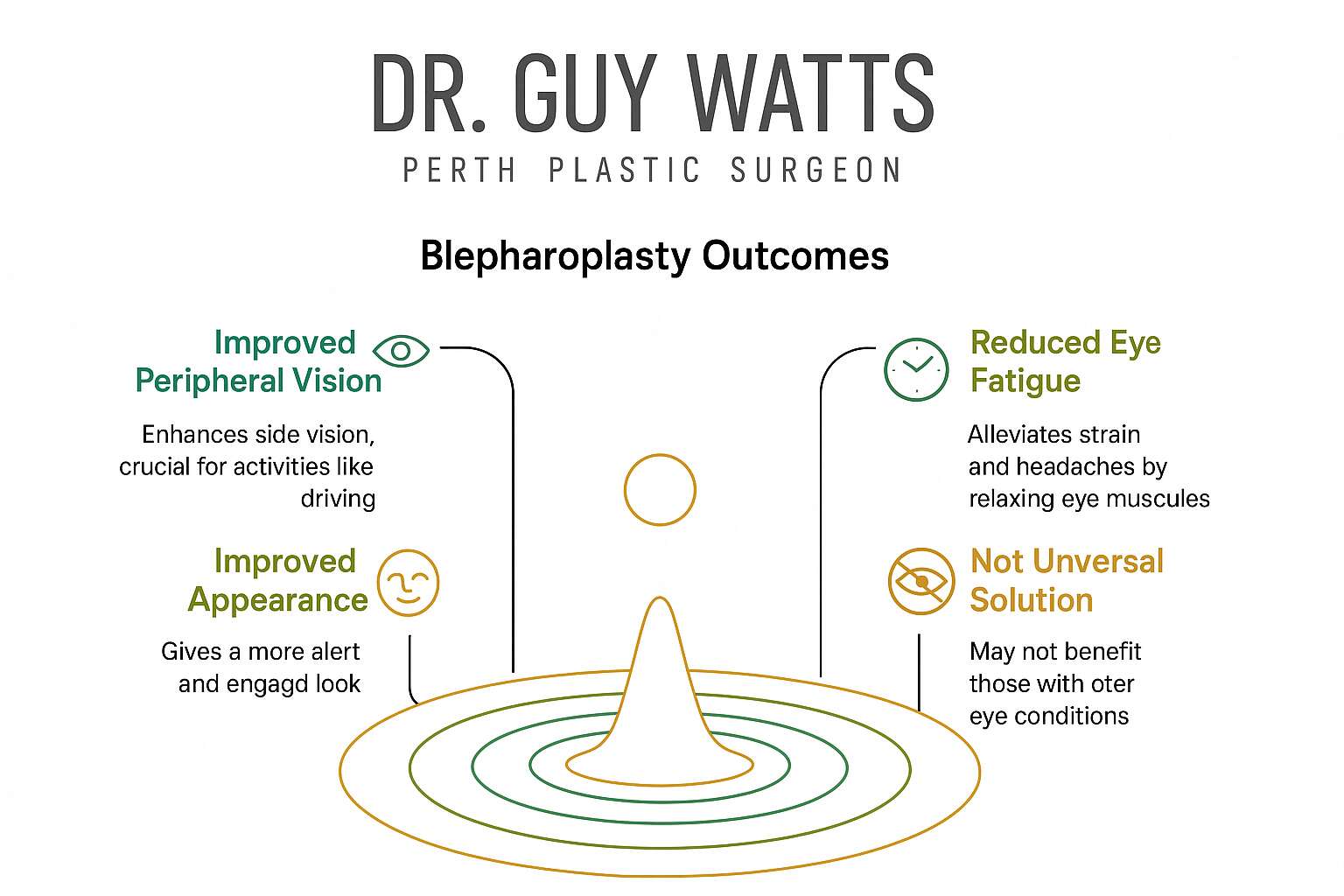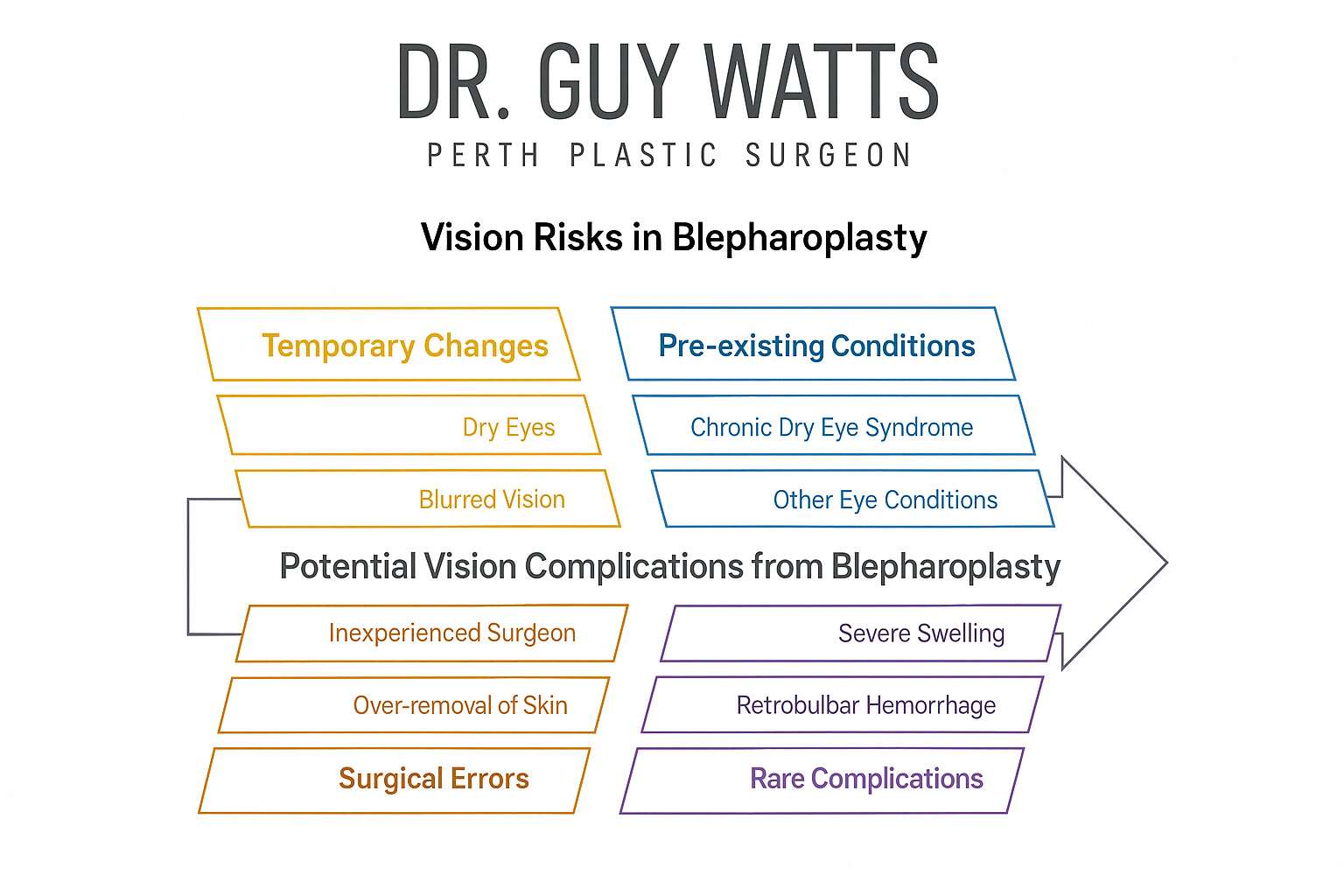
21 Apr Can Blepharoplasty Affect Your Vision?
Can Eyelid Surgery Help You See Better?
When you think about eyelid surgery, you probably see it as a cosmetic procedure and nothing more. But did you know that blepharoplasty can also affect your vision? If you have lax upper eyelids they could be physically blocking your line of sight. Perth Specialist Plastic Surgeon Dr. Guy Watts has many years of experience performing blepharoplasty surgery and other face and body procedures.
Many people don’t realise just how much their heavy, lax eyelids affect their day-to-day life. You might find yourself raising your eyebrows to see better, struggling with peripheral vision when driving, or experiencing frequent eye strain. In some cases, excess skin around the eyes can even cause headaches or make reading for long periods uncomfortable.
At the same time, you may have concerns about whether blepharoplasty could negatively affect your eyesight. Will your vision be blurry after surgery? Could there be any long-term changes? These are completely valid questions, and it’s important to understand how the procedure works and what to expect.
Take our quiz, and find out if you are ready for surgery
How Heavy Eyelids Affect Vision
Your eyelids do more than just protect your eyes—they play a role in how well you see the world around you. If your upper eyelids start to become lax or heavy, they can create a physical obstruction in your field of vision, particularly in the upper and outer areas. This can happen gradually, so you may not immediately realise how much your eyesight has been affected.
One of the more common causes of lax eyelids is ageing. As you get older, the skin around your eyes loses elasticity, and the muscles responsible for lifting your eyelids weaken. This can lead to a condition called dermatochalasis, where excess skin folds over the eyelid margin, sometimes resting on your eyelashes. If the laxity is significant, it can narrow your field of vision, making regular tasks such as reading, driving, or watching television more difficult.
Another condition that can impact your vision is ptosis, which occurs when the muscle responsible for lifting your eyelid (the levator muscle) becomes weak or stretches out over time. This can cause one or both eyelids to hang lower than normal, further restricting your vision and giving you a tired, heavy-eyed appearance.
If you often raise your eyebrows in an attempt to lift your eyelids, you’re not alone. Many people instinctively do this to compensate for their restricted vision. However, this constant effort can strain the forehead muscles, leading to chronic headaches, tension, and fatigue.
In severe cases, heavy eyelids can affect more than just your daily activities. Some people find they struggle to recognise faces from a distance, miss details in their peripheral vision, or feel uncomfortable driving at night. If you’ve noticed any of these changes, a consultation with a specialist like Dr. Guy Watts could help you understand whether blepharoplasty is the right solution.
Download Dr Watts’ Ultimate Guide to Blepharoplasty

Can Blepharoplasty Address Vision?
For patients with significant eyelid laxity, blepharoplasty can do more than alter appearance—it can help address vision clarity. By removing excess skin and repositioning the eyelids, the surgery helps to open up the visual field, making everyday tasks easier and less onerous.

✔ Better Peripheral Vision
- One of the biggest functional benefits of blepharoplasty is the improvement in peripheral vision. When the upper eyelid droops too much, it can block light from entering the eye properly, reducing what you can see from the corners of your eyes. This can be particularly problematic when driving, as it makes it harder to spot vehicles, pedestrians, or cyclists in your side view.
✔ Reduced Eye Fatigue and Strain
- If you’ve been unknowingly compensating for heavy eyelids by lifting your forehead muscles, you may be experiencing chronic eye strain or tension headaches. Blepharoplasty removes the need to overuse these muscles, allowing your eyes and forehead to relax.
✔ A More Refreshed, Awake Look
- Although the main goal of functional blepharoplasty is to address vision, an added bonus is that it can make you appear more alert. When your eyes are more open, you appear more engaged.
While blepharoplasty can address vision for those with excess eyelid skin or ptosis, it’s not a one-size-fits-all solution. If your vision issues are related to other eye conditions, such as cataracts or glaucoma, eyelid surgery may not be the answer. This is why a consultation with a specialist is essential—he will assess your unique concerns and medical history to determine whether surgery is right for you.
Temporary Vision Changes After Surgery
It’s natural to have concerns about what to expect in the days and weeks following blepharoplasty. While the surgery itself is designed to improve vision in the long term, temporary changes in eyesight are completely normal during the healing process.
What to Expect Immediately After Surgery
After the procedure, your eyelids will be swollen, and there may be some bruising and mild discomfort. You might notice that your vision feels slightly blurry or cloudy—this is usually due to:
- Swelling around the eyes, which can temporarily distort vision.
- Ointments or eye drops applied after surgery, which can create a slight film over your eyes.
- Temporary dryness, as your eyes adjust to the new shape of your eyelids.
These changes are usually mild and resolve within a few days to a few weeks as the swelling decreases.
Blurry Vision: Is It Normal?
Blurry vision is one of the more common temporary side effects of blepharoplasty. It can be caused by:
- Post-surgical swelling pressing slightly on the eye.
- Minor corneal irritation from the procedure.
- Tearing or dryness, which affects how light refracts through the eye.
Most patients find that their vision steadily improves within a week or two. Using prescribed eye drops can help keep your eyes comfortable during this period.
Light Sensitivity and Double Vision
Some patients experience sensitivity to light after surgery, making it uncomfortable to be in bright environments. This happens because your eyes are adjusting to their new exposure—previously, your heavy eyelids may have blocked out some of the light. Wearing sunglasses and avoiding direct sunlight can help until your eyes fully adapt.
A small number of patients report mild double vision in the first few days post-surgery. This is typically due to temporary swelling affecting eye alignment and should resolve on its own. If double vision persists beyond a couple of weeks, it’s important to discuss it with Dr Watts.
Difficulty Closing the Eyes
In rare cases, some patients struggle to fully close their eyes after blepharoplasty, particularly if too much skin is removed. This can lead to dryness and irritation, especially at night.
How Long Does It Take to See Clearly Again?
For most people, vision returns to normal within a few weeks. The biggest changes happen once the initial swelling subsides—usually around two to four weeks post-surgery. Some minor changes, such as final eyelid settling, can continue for a few months.
Key tips for a steady recovery:
✔ Use prescribed eye drops to keep your eyes lubricated.
✔ Rest with your head elevated to reduce swelling.
✔ Wear sunglasses to protect against light sensitivity.
✔ Avoid strenuous activities for at least two weeks.
✔ Follow Dr Watts’ aftercare instructions carefully.
When to Seek Medical Advice
While temporary vision changes are normal, you should contact Dr Watts if you experience:
- Severe or persistent pain that doesn’t improve.
- Sudden vision loss or extreme blurriness.
- Inability to close your eyes fully, causing discomfort.
Can Vision Be Negatively Affected by Blepharoplasty?
Blepharoplasty is a highly effective and generally low risk procedure when performed by an experienced surgeon. However, like any surgery, it does come with some potential risks. While vision-related complications are rare, it’s important to understand what could happen and how to manage risks.
Temporary vs. Permanent Vision Changes
Most vision-related changes after blepharoplasty are temporary and part of the healing process. These can include:
- Blurred vision due to swelling or ointments used post-surgery.
- Dry eyes, which can cause discomfort and momentary blurriness.
- Light sensitivity, especially if your eyelids were previously blocking some light.
- Minor double vision, in rare cases, due to swelling affecting eye muscle balance.
These effects typically resolve within a few days to weeks and are not a cause for concern.
Can Blepharoplasty Make Vision Worse?
Severe vision complications are exceptionally rare, but it’s still good to be informed. Possible risks include:
-
Difficulty Closing the Eyes (Lagophthalmos)
- If too much skin is removed, you may struggle to fully close your eyes, particularly at night.
- This can lead to dryness, irritation, and discomfort because your tears evaporate too quickly.
- In most cases, this is temporary and improves as swelling subsides, but severe cases may require additional treatment.
-
Persistent Dry Eyes
- Some patients may notice worsened dry eyes after blepharoplasty.
- If you already have chronic dry eye syndrome, your surgeon may recommend modifications to the procedure or alternative treatments.
-
Lower Eyelid Malposition (Ectropion or Retraction)
- If too much lower eyelid skin is removed, the eyelid may be pulled downwards, exposing more of the white of the eye.
- This can cause irritation, excessive tearing, and difficulty blinking.
- In most cases, post-surgical swelling can temporarily make the lower lid look different, but permanent changes are rare with a skilled surgeon.
-
Bleeding Behind the Eye (Retrobulbar Haemorrhage) – Extremely Rare
- This is an exceptionally rare complication where bleeding occurs behind the eye, potentially increasing pressure and affecting vision.
- If left untreated, it could lead to serious issues, but surgeons take extreme precautions to avoid this.
How to Reduce Risks
The optimal way to manage risks and enjoy a steady recovery is to follow Dr Watts’ recommendations carefully:
✔ Choose an experienced specialist like Dr. Guy Watts, who understands both the aesthetic and functional aspects of eyelid surgery.
✔ Discuss your medical history, particularly if you have dry eyes, prior eye surgeries, or any vision concerns.
✔ Follow post-operative care instructions to support healing and avoid complications.
✔ Attend follow-up appointments so your surgeon can monitor your recovery.
If you experience any persistent vision issues, severe pain, or an inability to close your eyes properly, it’s important to seek medical advice right away.
FAQs about Blepharoplasty and Vision
Further Reading about Face Procedures
- Read more about Sunken Eyes – Causes and Solutions
- Read more about When to Resume Exercising after Facelift Surgery
- Read more about What Is Facial Asymmetry
- Read more about 7 Tips to Reduce Bruising after Facelift Surgery
- Read more about Swelling and Bruising after Blepharoplasty
Next Steps on Your Plastic Surgery Journey
About Dr. Guy Watts – MED0001539378
FRACS (Plas) – Specialist Plastic Surgeon In Perth WA
Dr. Guy Watts is a Specialist Plastic Surgeon (AHPRA MED0001539378) with an extensive career that spans across renowned plastic surgery clinics worldwide. His experience has been honed through invaluable experiences at esteemed establishments such as the New York Eye and Ear Infirmary and the renowned Pitanguy Clinic in Brazil.
Having collaborated with the foremost cosmetic plastic surgeons on a global scale, Dr. Watts has chosen to return to Perth after a 17-year journey of intensive training and invaluable professional experience to bring the latest practices and technology in cosmetic plastic surgery to his patients.
Dr. Watts is a Fellow of the Royal Australasian College of Surgeons (FRACS) and a Member of the Australian Society of Plastic Surgeons (ASPS), Australasian Society of Aesthetic Plastic Surgeons (ASAPS) and the International Society of Aesthetic Plastic Surgeons (ISAPS).
Read about the potential Risks and Complications of Surgery
Read the Patient Information and Resources
About CLINISPA
Clinispa is Dr Watts’ bespoke medical clinic performing Cosmetic Aesthetic treatments. At Clinispa, we offer advanced clinical treatments in a luxurious and calming environment, tailored to support your skin’s health and appearance.
Clinispa aesthetic services are performed by Dr Guy Watts’ nursing professionals, who have a passion for and solid understanding of facial aesthetics.
All Clinispa clients are considered individually, with a personalised treatment plan consisting of advanced scientific approaches to cosmetic aesthetics. We incorporate innovative technologies in conjunction with superiorly formulated skin care.
For more information about the full range of Clinispa Aesthetic of Cosmetic Treatments visit the Clinispa website









Sorry, the comment form is closed at this time.